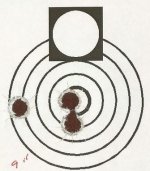Well I suppose you could fully load the case with IMR 4831, and get a maximum velocity of 720 fps out of a 22 inch barrel.
Most of this old data got dumped once ammunition companies dumped copper pressure testing. I called Alliant, Hercules just to have some sort of a rifle/pistol load with all their powders. Then they stopped. It is my recollection they had Blue Dot loads in rifle calibers. Anyway, that was the point of discussion, Blue Dot loads in rifle calibers. Alliant told me that with the piezo electric test equipment they are able to look at the pressure curve in real time and are able to see irregularities, scary pressure curve slopes, etc. You did not see this with crushers. The scary pressure curve slope was directly related to Blue Dot in rifle calibers: small changes in anything made huge changes in pressure. There is a promoter named Seaforth who popularized Blue Dot loads in rifle calibers, and occasionally, someone blows up their rifle with his recommendations. It is all due to the unpredictability of the powder in the application. The shooters who blew up their rifles think they double charged the load, and they could have, but their blowups could be due to using an inappropriate powder and load combination.
So, that was when I found that Alliant had dumped a lot of old data, and was now, only recommending powder/charge/cartridge combinations that made sense, and were safe on the pressure barrel.
So, I think this is what has happened with these IMR powder combinations. Does anyone want 720 fps loads out of their 44 Magnum rifle? Not me. Are rifle powders the best way to have 720 fps loads, don't know, but it sure would be the most expensive.

